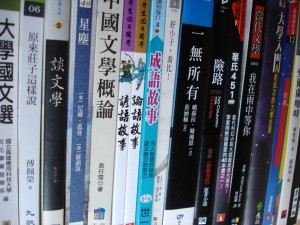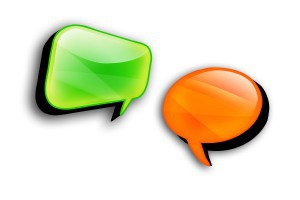 The f word is a sensitive one in language learning contexts, and can mean almost anything depending on who’s using it. Today, we’re going to discuss how to become fluent in Chinese listening, speaking, reading and writing, where “fluent” simply means being able to use Chinese smoothly and effectively to achieve communicative goals, regardless if it’s expressing yourself or understanding others.
The f word is a sensitive one in language learning contexts, and can mean almost anything depending on who’s using it. Today, we’re going to discuss how to become fluent in Chinese listening, speaking, reading and writing, where “fluent” simply means being able to use Chinese smoothly and effectively to achieve communicative goals, regardless if it’s expressing yourself or understanding others.
In this context, “fluent” is not used as a synonym for “advanced”, but rather as a way to distinguish mastery from merely knowing about something. This means that today’s article is relevant for learners on all levels, including beginners, who can certainly be fluent in Chinese, albeit in a limited area.
Tune in to the Hacking Chinese Podcast to listen to the related episode:
Available on Apple Podcasts, Google Podcasts, Overcast, Spotify, YouTube and many other platforms!
To be fluent is to be very good at applying what you know
Being able to express yourself smoothly and effectively is more about being good at applying what you know, rather than knowing everything. Quantity plays a role, but quality is more important. As I have demonstrated in an earlier article, it’s possible to express oneself fluently in speaking or writing using only a thousand words or so, even about topics such as second language acquisition. This, however, requires you to be very good at using the words you know. This is what this article is about.
When it comes to understanding what other people say, it’s not enough to just know a word, you need to know it so well that you can recall its meaning instantly, and be able to recognise it in different contexts. When reading, fluency demands a high level of automated processing of characters, since stopping every five words or so to try to remember what something means doesn’t meet anybody’s definition of “fluent”. This is also what this article is about.
Fluency development – one of four strands
Fluency development is one of Paul Nation’s four strands, a framework I refer to occasionally here on Hacking Chinese, and introduced properly in a recent article: Analyse and balance your Chinese learning with Paul Nation’s four strands.
Analyse and balance your Chinese learning with Paul Nation’s four strands
In his 2007 article, Nation defines fluency development as activities where (p. 7):
- All of what the learners are listening to, reading, speaking or writing is largely familiar to them. That is, there are no unfamiliar language, or largely unfamiliar content or discourse features.
- The learners’ focus is on receiving or conveying meaning.
- There is some pressure or encouragement to perform at a faster than usual speed.
- There is a large amount of input or output.
Number one is not hard to understand, because if we want to get better at using what we already know, we need to focus on familiar language and content. If there are too many unknown words, for example, focus will automatically shift to dealing with the unfamiliar language, which is exactly what we don’t want.
I will probably write a separate article discussing number two and why you want more meaning-focused practice, but for now, it’s enough to say that the main focus should be on using Chinese to actually communicate with another person, or trying to understand what they are saying or writing. If you’re not receiving or conveying meaning, the activity isn’t meaning-focused, which disqualifies maybe 90% of all textbook exercises I’ve seen and a good chunk of activities that take place in language classrooms too, especially at university.
Number three is unique for fluency development, because like I said above, fluency is to a large extent about not just knowing something, but knowing it fast. This is crucial for all four skills, although it’s less pressing when reading or writing, because we often have more control over how much time we spend and where we spend it. When listening or speaking, however, taking too long to recall something can be as bad as not knowing it at all. I discussed this in more depth when it comes to listening and reading in these two articles:
1. Chinese listening strategies: Improving listening speed
2. How important is reading speed on tests like HSK and TOCFL?
Speed is central to fluency development, but it can manifest itself somewhat differently. First, we can try to do something faster. Second, we can choose content where speed follows naturally, such as revisiting familiar content or focusing on language well within our comfort zone.
Nation has researched the role of timed exercises and focus on speed, and concluded that they not only increase fluency, but also have positive effects on accuracy (see the reference list at the bottom of this article for specific references).
Fluency development as part of your personal curriculum
In Nation’s framework, each strand is supposed to take up one fourth of the study time, but in reality fluency development usually takes up much less than that. Exactly how much depends on where you’re learning Chinese, including if you’re learning on your own or are enrolled in a course.
If you’re enrolled in a course or studying independently, my goal is to persuade you to invest more time in fluency development and show you how you can do that.
If you’re a teacher, I want to convince you that you should make fluency development a part of your course, although not necessarily fully in class, especially not if you teach adults who can be relied on to spend time on learning outside your lessons.
Which textbook or HSK level you’re in is a very poor measure of fluency
Fluency development is one of the most neglected areas of institutional language learning, especially in formal situations that value quantitative goals. I’ve studied Chinese at many different language schools and several universities, and most of them have strict rules about how quickly students should progress in textbooks.
It’s as if the curriculum designers think that having gone through a chapter guarantees that students have mastered the content, so the class that finishes the most chapters by the end of the semester has the best teacher and the best students.
Sometimes it feels like educators don’t think that one is studying seriously unless the students learn a ton of new words and grammar patterns. This is painfully clear when engaging with some private tutors, who seem to think that their quality is best judged by how much new vocabulary they can cram into a lesson.
Fluency development is not limited to the classroom
Naturally, students who learn Chinese full time in an immersion environment will get plenty of practice outside the classroom, and Nation’s four strands are meant to cover all learning, not just what goes on in class.
Still, I think it’s safe to say that most students vastly overestimate the importance of superficial, easily quantifiable signs of progress, such as finishing a textbook, learning a thousand characters, passing a certain HSK level, and therefore underestimate the importance of consolidating what they already know. They neglect fluency development, in other words. This is even more true if you’re learning Chinese in your home country, in which case fluency development might be lacking entirely, since most students will never do it spontaneously outside class. I wrote more about this problem here: Language is communication, not only an abstract subject to study
Language is communication, not only an abstract subject to study
How to become fluent in Chinese listening, reading, speaking and writing
Now that we know what fluency development is and why it’s important, let’s look at activities and exercises you can use. You can of course come up with your own using the criteria I listed above, but I think some inspiration to get started is in place. These are not the only options and probably aren’t the best either; they are just ones I use when learning and teaching Chinese. If you have your own to contribute, please leave a comment below and I will consider adding it to the article!
Developing fluency in Chinese listening
 As discussed in the article about listening speed linked to above, fluency is absolutely crucial for listening. Unless you’re listening to a recording you can easily stop, rewind or slow down, you usually don’t have time to search for the meaning of a word; it has to just pop up when needed, preferably without you having to pay attention to it at all.
As discussed in the article about listening speed linked to above, fluency is absolutely crucial for listening. Unless you’re listening to a recording you can easily stop, rewind or slow down, you usually don’t have time to search for the meaning of a word; it has to just pop up when needed, preferably without you having to pay attention to it at all.
Here are a few activities to develop fluency in Chinese listening:
- Listen to spoken Chinese below your current level. Remember, for something to count as fluency development, it needs to contain almost no new words or grammar. By encountering language you know over and over in different contexts, the time you need to make sense of it will decrease. Because the level is relatively easy, you can listen a lot.
- Listen to the same recording again or re-listen to old audio. Unless you’re listening to something really easy, you won’t understand everything the first time. Every additional time you listen will bring further understanding, and at some point, this starts counting as fluency development. The exception is if the recording contains too much Chinese you simply don’t know, in which case you’re learning new things, not getting better at what you already know.
- Adjust the speed of the Chinese you listen to. This is a complex topic I plan to revisit in a separate article, but there are at least three different ways in which the speed of the Chinese you listen to can vary. First, the speaker can talk slower, which usually also means that pronunciation changes, because people who speak slowly tend to enunciate and pronunciation is altered by rate of speech in general. For example, a higher rate of speech results in more tone changes, more assimilation, more reduction in unstressed syllables, and so on. Second, pauses can be strategically inserted between sentences, giving you as a listener time to process what was said without altering the rate of speech. Third, you can use computer software to slow down audio, which retains all the characteristics of fast speech while allowing you more time to process it. For fluency development, you want to move away from slowly enunciated Chinese, the hallmark of textbook audio and Chinese learning materials in general.
If you want suggestions for what to listen to, check: The 10 best free listening resource collections for learning Chinese
https://www.hackingchinese.com/the-10-best-free-listening-resource-collections-for-learning-chinese/
You can also check my posts about the listening challenges I run over at Hacking Chinese Challenges, which always contains an updated list of things to listen to:
Developing fluency in Chinese reading
 While you can often take your time when reading, fluency development is about covering more text in less time. For this to work, it has to be easy. Here are some suggestions for improving fluency in Chinese reading:
While you can often take your time when reading, fluency development is about covering more text in less time. For this to work, it has to be easy. Here are some suggestions for improving fluency in Chinese reading:
- Read Chinese below your current level. I already talked about this for listening, and the logic is the same, so I’ll keep this brief. Graded readers, such as Mandarin Companion, are the best, but you can also rely on several different textbooks for a similar effect, especially on lower levels.
- Rereading, especially with a specific purpose in mind, can also be an option. Skimming or scanning a text for specific things works well. Playing text adventure games on WordSwing is great, because you’ll revisit the same scenes many times and read the same options over and over, but since you need to be on the alert for new options or a change in the scene, you still need to pay attention. We deliberately scramble the order of the choices to encourage readers to do this!
- Simply try to read faster. While speed reading sounds very ambitious for second language learners who struggle with basic literacy, it can still be a worthwhile effort to challenge yourself to read easy passages quickly. You can always reread them for further practice and full understanding. For speed reading in particular, check this article: Chinese reading speed revisited
- Read many texts about the same topic. This is called “narrow reading”, and the idea is to extend your comfort zone by reading many texts about one topic, instead of having a completely new topic for each text. For example, you might read ten different accounts of a news event or five different plot summaries of the same book. The first few times probably won’t count as fluency development, but the more you keep reading about the same topic, the closer to fluency development you get.
For reading resource recommendations, check:
The 10 best free Chinese reading resources for beginner, intermediate and advanced learners
The 10 best free Chinese reading resources for beginner, intermediate and advanced learners
The 7 best Chinese reading resources for beginners
https://www.hackingchinese.com/beginner-chinese-reading/
Developing fluency in Chinese speaking
 Speaking is what most people associate with fluency, so let’s see what you can do to achieve that.
Speaking is what most people associate with fluency, so let’s see what you can do to achieve that.
- Talk about the same topic more than once. People who live in a Chinese-speaking environment sound significantly more fluent when talking about why they’re learning Chinese than almost any other topic, for the simple reason that they do this over and over. By talking about the same thing with several different people, you gradually become more fluent. You can do this systematically, too, such as in a classroom, by mixing up who talks with whom, but keeping the topic the same
- Talk about the same topic with less and less time available. An example of this is “4/3/2” exercises, referring to the idea of having to talk about something, first in four minutes, then three, then two. This type of activity works well, both with conversations (ask each other and answer these questions within the given time limit) or presentations (introduce yourself, your country or your research project in gradually shorter periods of time). The numbers 4/3/2 are of course arbitrary.
- Play word games where you describe words without being able to say them. This strengthens your ability to use the Chinese you know, and if you think about it, not being allowed to say a word is similar to not knowing the word, so playing this kind of game is great for navigating your way around holes in your vocabulary. In my opinion, this is both the most fun and one of the best ways of practising fluency! I’ve written an entire article about this here: How to improve fluency in Chinese by playing word games
Developing fluency in Chinese writing
 As we saw with reading vs. listening, writing is normally not as time-dependent as speaking is. Being able to write Chinese fluently is useful, but for most people, not nearly as useful as being fluent in speaking and listening. Outside proficiency tests, it’s rarely a requirement to have to write quickly. This, however, doesn’t mean that fluency development is not interesting, it just means that the need is less pressing. For some students, writing might actually be very important too!
As we saw with reading vs. listening, writing is normally not as time-dependent as speaking is. Being able to write Chinese fluently is useful, but for most people, not nearly as useful as being fluent in speaking and listening. Outside proficiency tests, it’s rarely a requirement to have to write quickly. This, however, doesn’t mean that fluency development is not interesting, it just means that the need is less pressing. For some students, writing might actually be very important too!
On the whole, fluency development for writing works much the same way as for speaking, meaning that writing about the same topic while varying the time frame, audience and purpose works well.
This is especially true if you suffer any kind of writer’s block and find it incredibly hard to write anything at all. Choose a topic you know reasonably well, set a timer for 10 minutes and focus only on conveying meaning about that topic until the alarm goes off. You don’t need to show this to anyone, so don’t worry about accuracy. You can then repeat this or revisit the topic again later. You can also use this as the first step in a more serious writing project, which is one of the things I suggest in my article about writing: 20 tips and tricks to improve your Chinese writing ability
Practise fluency and reap the benefits
The list above is not exhaustive, but I hope that I have shown enough examples and explained the principles behind them so that you can make smart decisions about your own fluency development.
Remember, fluency is mostly about being really good at what you already know, and this typically doesn’t come automatically if you’re always focusing on learning new things. Make sure that you don’t always feel like you’re drowning in new words!
References
Arevart, S., & Nation, P. (1991). Fluency improvement in a second language. RELC journal, 22(1), 84-94.
Chung, M., & Nation, P. (2006). The effect of a speed reading course. English Teaching (영어교육), 61(4), 181-204.
Nation, P. (2007). The four strands. International Journal of Innovation in Language Learning and Teaching, 1(1), 2-13.

Tips and tricks for how to learn Chinese directly in your inbox
I've been learning and teaching Chinese for more than a decade. My goal is to help you find a way of learning that works for you. Sign up to my newsletter for a 7-day crash course in how to learn, as well as weekly ideas for how to improve your learning!